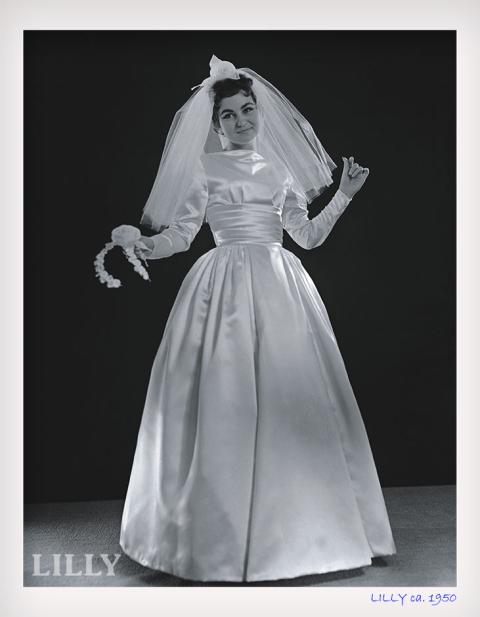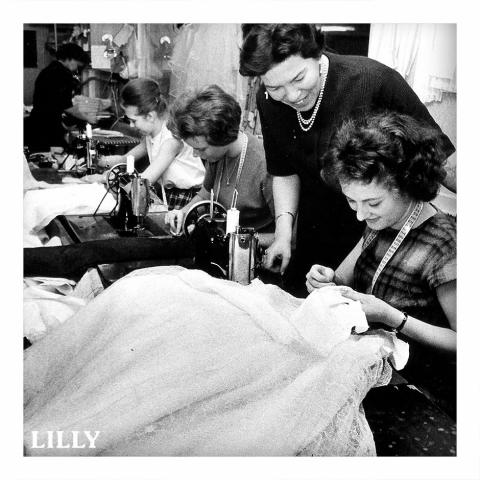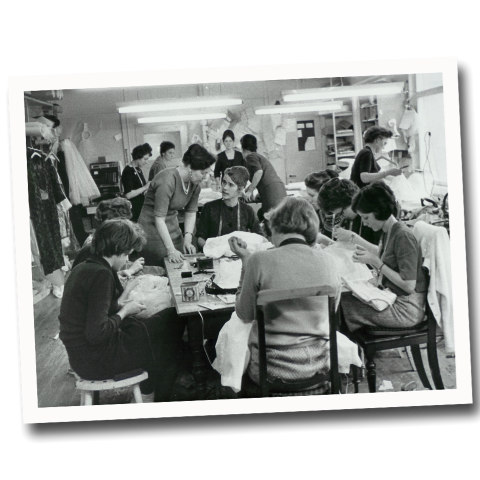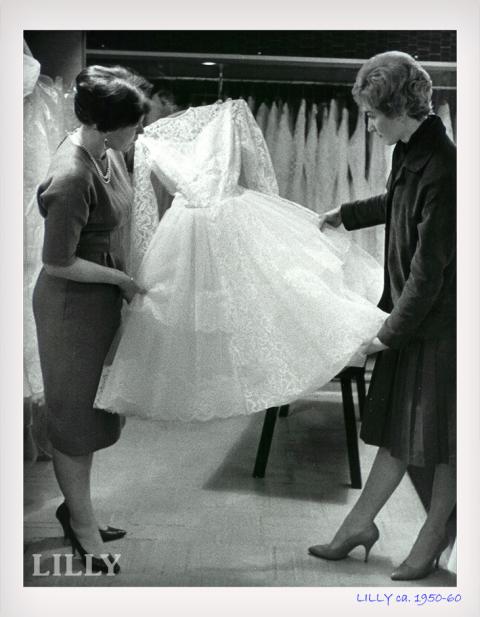



LILLY - a success story
For more than 70 years the scandinavian brand "LILLY" has been creating inspirational bridalfashion - with a lot of love and know-how - for brides throughout Europe.
The founding of LILLY
In the summer of 1946 the then 28-year-old Lilly Hansen decided to become self-employed as a seamstress. On a'conto she bought a red SINGER sewing machine, which was paid in the following year with about 1 euro per month. She rented the new business premises in an unfinished house and the responsible craftsman, promised to have everything done in time for the opening 1rst September 1946. Unfortunately he didn't make the deadline but came up with a transitional solution, where he offered her to share his own workshop with her (it was in the same building). As a result a big sheet was hung up in the middle of the room dividing his workshop in two: On the one side was the "Lilly's Dress-Atelier" and on the other side the workshop of "Svend Brændgaard Hansen & Co". After a while Lilly started wondering what the delay was all about and confronted the builder and it turned out he had fallen in love! The "partnership" would last a lifetime and in 1999 the they celebrated their 50th wedding anniversary.
The beginning...
In the beginning, Lilly recreated ladies' wardrobes, e.g. suits, dresses or jackets. She was not only a gifted businesswoman but also an incomparable design talent with a lot of craftsmanship and a great love for details. One of the first customers who entered, was a young lady and her mother, who placed an order for a wedding dress, to be made out of an english silk parachute that they had saved. This became the starting shot for LILLY's success story: for those who wanted to wear a new weddingdress in the post-war period - a time when clothing and fabrics were very rare and precious - it was important to find a company, that could accomplish the miracle of making five-meters of fabric look like 30! Word quickly spread, and during the next ten years brides from all over Denmark came to Vejle to have their weddingdress made by Lilly. And soon she concentrated entirely on bridal and evening wear as the core business of the newborn "LILLY" brand.
The following years...
Gradually additional seamstresses were hired to handle the assignments and the business expandended with collections of ready-made weddingdresses and eveninggowns.
LILLY shops soon followed in alle the major cities of Denmark and in 1978 the first LILLY shop opened in Flensburg, Germany. Today you can visit LILLY bridal shops in Denmark, Germany and Sweden, aswell as find the brand represented in renowned bridalstores throughout Europe.
The second generation
Lilly's daughter, Annemarie, had inherited the love of fabrics and tailoring, and in her early years she often enjoyed herself in the sewing room. Her first job as a five-year-old was to pick up pins from the ground with a magnet suspended from a cord. At the age of 13, she worked in the studio every day after school and she opened her first store in Copenhagen at the age of 17, adding another milestone for LILLY. Annemarie and her two brothers expanded the network of LILLY stores in Germany. Annemarie was a master of fabrics, cut and high quality. For her, it was more passion than work, to create new design ideas and this passion was inherited by her daughter, Eva-Dorthe Rantzau Smith, who joined the company in 1990 and is now the creative heart of LILLY.
The 3rd generation
Today, Eva-Dorthe Rantzau Smith, together with her sister Anne Kathrine Rantzau Ulrich and cousin Betina Brændgaard Tolstrup, successfully lead the family business in it's 3rd generation. Eva-Dorthe is the creative mind behind all the different LILLY collections - each with its very own character and variety of styles. As a specialist for occassionswear, LILLY's portfolio also includes fashion for eveningwear, bridesmaids, flowergirls, communion and christening.
LILLY-philosophy
The LILLY collections take on new trends and merge them with timeless elegance, always at very convincing price-levels and in exquisite quality.
Travel with LILLY through time:
Fashion trends and ideas in bridalfashion have changed over the decades. Only one thing is everlasting: the wedding dress must be fashionable and radiate WOW-feeling!
40s
A typical dress from the 1940s was made of soft, shining silk, with high necklines and long sleeves. The wedding dress was closed with buttons, which were used as a style element. From the high waist unfolded a wide skirt, which was often quilted at the hem. The bridal look was completed by a veil that gently framed the face, as well as a bridal crown and - of course - myrtles.
50s
In the 1950s, the high waist and wide-skirts were dominating. The dresses were very romantic, with long sleeves and high necklines, often with collar. Towards the end of the fifties the skirts became shorter: the bride wore the popular tea-length. Buttons closed the feminine designs, veil and crown were the bride's favorite accessories. Style-icons of this time were: Grace Kelly and Coco Chanel.
60s
To marry decent and high-necked was still very "en vogue". The Princess style was favored and frack dresses were very popular. As a novelty brocaded fabrics and the mini skirt appeared. Style-icons of this time were: Twiggy and Jacqueline Kennedy.
70s
At the height of flower power fashion: Large, wide sleeves with soft flowing skirts were MUST HAVE and the waistline became almost invisible. Dominant materials were satin, cotton and lace. The length of the dress varied between short, tea-lenght or long. The hair was worn open with expressive makeup. The wedding of the Swedish crown prince Carl Gustav with the German Silvia Sommerlath revolutionized the wedding fashion over night: the stylish and simple outfit inspired a whole new direction in bridal fashion.
80s
Prince Charles married Lady Diana Spencer in 1981. And again the wedding fashion changed overnight: Decent was yesterday - now large, lavish robes with puffed sleeves, ruffles and bows, as well as ultra-long trains, repressed the simple and puristic outfits of the previous decades. On the tulle and lace dresses, splendid rhinestones and pearl sequins were embroidered, the veils were elaborately draped around the brides head. Hats and lush floral headband were a hit.
90s
By the mid 90'es the fashion became simpler again - as an anti trend to the grand and oppulent dresses of the 80's - popular were skirts in the Princess and Empire style.
2000s
Separate corsets and skirts that could be put together individually was the new trend. Large romantic skirts were worn with simple tops and slim skirts with lush corsages. This "Mix and Match" system enjoyed great popularity in LILLYs collections as i allowed brides to 'create their own dress'-ensemble.
